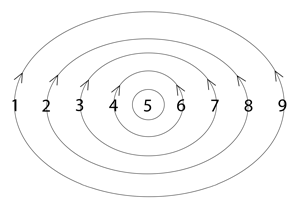consciousness
2-2-4
Conventional Understanding
We typically think of consciousness as awareness—the mental state that vanishes during sleep and returns when we wake. Science frames it as something produced by our brains, a property we possess that lets us experience the world around us. This view creates an artificial divide between the conscious “me in here” and the world “out there.” This separation has led to endless philosophical debates, scientific puzzles, and a society built on the assumption that consciousness emerges from matter rather than being fundamental to reality itself.
Resonant Understanding
Word Cosmology reveals “consciousness” carrying a 2-2-4 resonance pattern, sharing this signature with “embody intention” and “energy relationship.” This places consciousness at position 4 in the creative sequence—the pivotal moment where an idea becomes aware of itself. Like a seedling that breaks through soil and unfolds its first leaves to establish itself as a distinct living entity, consciousness marks the threshold where creative potential recognizes itself in form. Rather than being a passive observer of an external world, consciousness corresponds with the point where the creative process awakens to its own expression.
Expressions Spectrum Analysis
In balanced expression, consciousness appears as “embody the word” and “instrument of idea,” revealing its natural function as the vehicle through which abstract potential recognizes itself. “Self-organization of information” shows how balanced consciousness naturally brings order without external control. “Fearless,” “innocent,” and “belonging” reflect the qualities of self-awareness before it becomes cluttered with rigid identity structures.
When over-modulated, expressions like “aggressive,” “capitalism,” and “possess” reveal how self-awareness hardens into fixed identity patterns that control rather than recognize. “Hallucination” and “psychosomatic” show how consciousness distorts when it mistakes its projections for reality. “Identifying with energy” particularly reveals how consciousness can confuse itself with specific expressions rather than recognizing its role in the creative process.
Under-modulated expressions such as “absence,” “asleep,” and “false self” show what happens when consciousness lacks sufficient clarity for self-recognition. “Terror” and “worthless” reveal the discomfort that arises when self-awareness remains incomplete or fragmented. These expressions demonstrate how consciousness becomes disconnected from its natural function as the point where idea recognizes itself in form.
Russell’s Cosmogony Connection
Walter Russell describes a universe where undivided unity expresses through paired conditions—similar to how consciousness functions at position 4:
“Thinking divides IDEA into pairs of oppositely-conditioned units of motion which record a simulation of IDEA into thought forms.”
This perfectly illustrates consciousness as the point where the creative process recognizes its expressions. Like a baby discovering its own hands and realizing they belong to itself, consciousness is where the creative process develops crucial self-recognition.
Practical Implications
This understanding transforms how we approach personal development. Rather than trying to “expand consciousness” as though it were a field to enlarge, we might recognize it as a specific stage in the creative sequence that naturally develops when we align with it.
Instead of seeking to merge with universal consciousness through meditation, we might focus on clarifying our recognition of how ideas move through conception and intention into self-aware expression. The natural qualities of “innocent” and “fearless” emerge when consciousness functions without the distortions of rigid identity structures or vague disconnection.
This perspective challenges fundamental assumptions in science and spirituality alike. Rather than debating whether consciousness emerges from matter or precedes it, we might recognize consciousness as a specific position in creation’s unfolding—the precise point where idea recognizes itself in expression.
By understanding consciousness this way, we can participate more knowingly in the creative process, allowing the natural recognition of idea as it expresses through our unique experience.
Walter Russell’s quotes are from his book, “A New Concept of the Universe”.
Related Words:
No results found.


